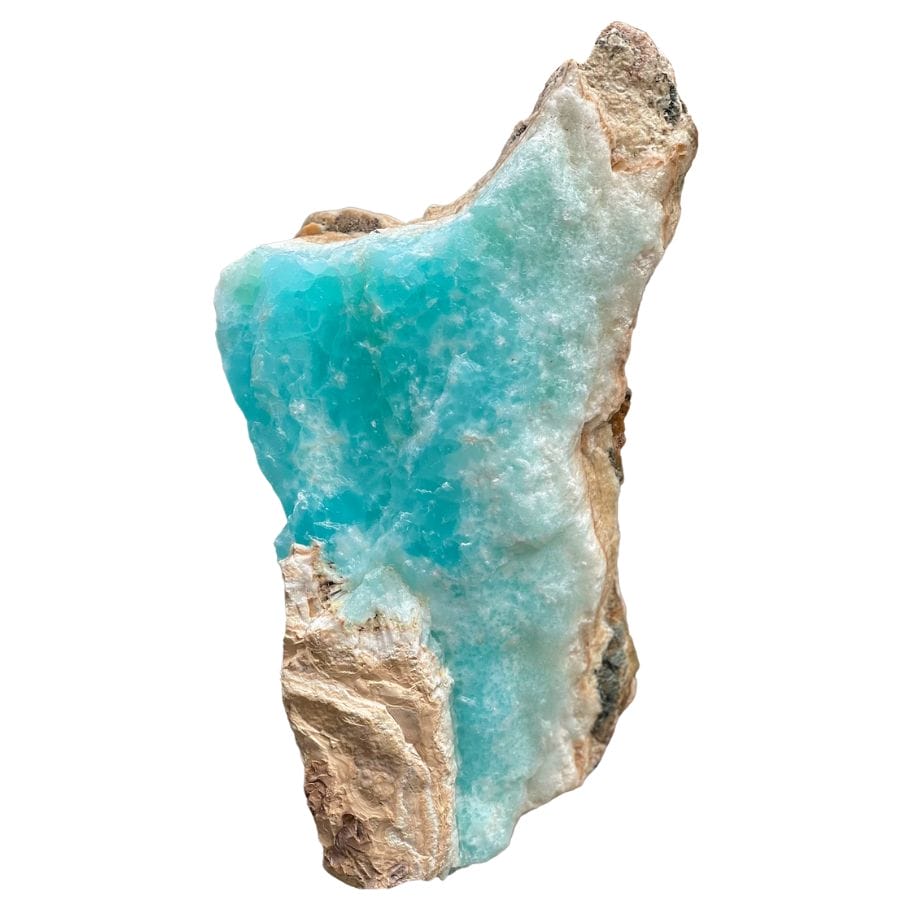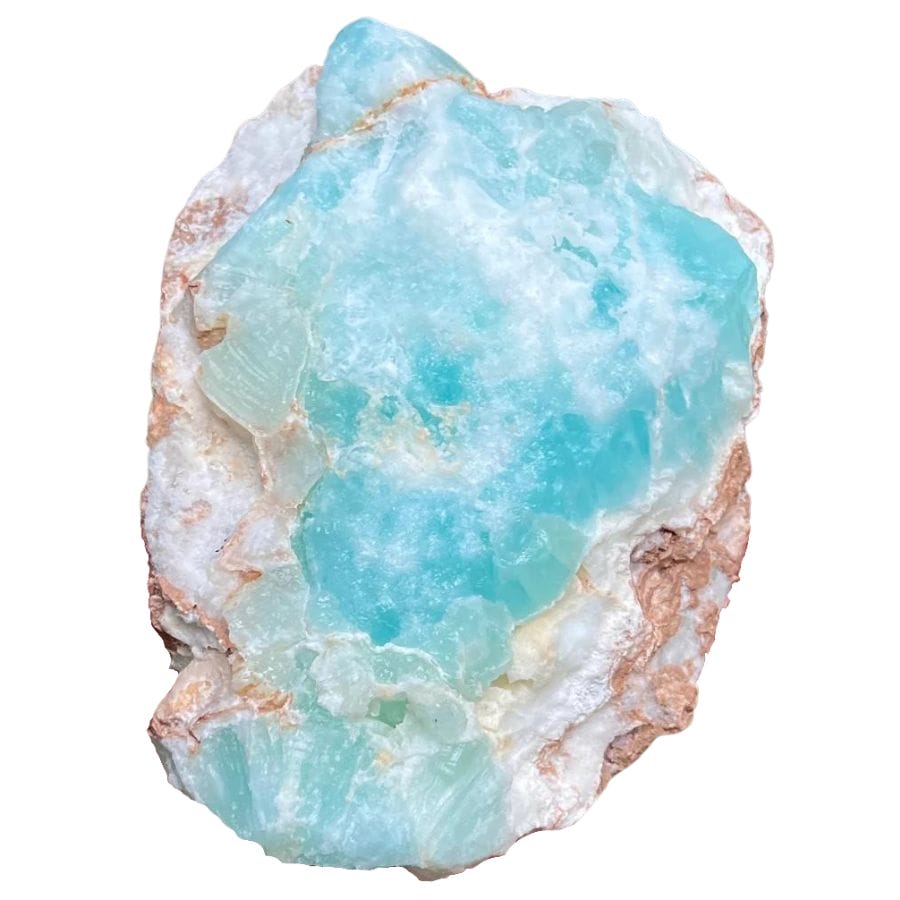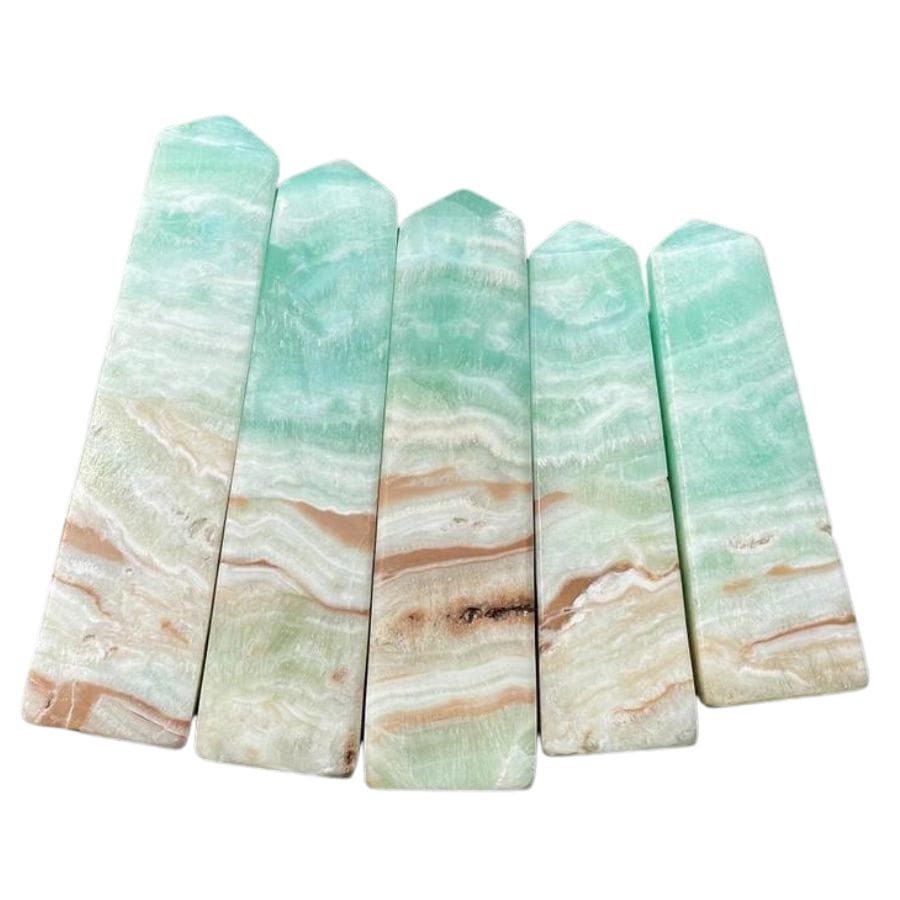Knowing how to tell blue aragonite vs Caribbean calcite apart is a skill that combines the sharpness of a detective with the wonder of a nature explorer. These two minerals might share pages in geology books, but they each have their own story.
Understanding the differences and similarities between these two stones can be like solving a mystery with clues hidden in plain sight.
Imagine this as a fun puzzle, where each rock holds its own set of clues. By understanding what makes each rock special, we get to appreciate the incredible world beneath our feet even more.
Blue Aragonite vs Caribbean Calcite – The Major Differences
Jumping into the world of rocks is always an adventure! Today, we’re focusing on two unique ones: blue aragonite and Caribbean calcite. While they might look similar, they have some interesting differences.
Colors – Blue aragonite typically comes in blue and white

The different elements that mix together to form the mineral also give the mineral its colors. These elements are like ingredients in a recipe. Just like different ingredients can change the color of a cake, they can change the color of a mineral too.
Comparing Caribbean calcite vs blue aragonite in color is a bit like comparing the sea with the sky.
Blue aragonite has colors that remind you of a clear sky, ranging from blue to soft white shades. It’s pretty straightforward, usually sticking to this color scheme that makes you think of looking up on a sunny day.
Sometimes, a piece of blue aragonite gets layers of brown or beige rock mixed in, which makes it look like Caribbean calcite.
Caribbean calcite is like a snapshot of where the ocean meets the beach. It shows off creamy colors that could remind you of the warm sand under your feet. Then it mixes in waves of blue that can make you think of shallow sea waters.
Luster – Caribbean calcite can have a vitreous or pearly luster

Luster is the word we use when we talk about the way light interacts with the surface of a mineral. Just like some things might be shiny like a mirror or dull like a chalkboard, different minerals have different kinds of shine, too!
Blue aragonite has a range of lusters. Sometimes it’s vitreous, which means it shines like glass. Other times, it can look waxy, like a candle, or even resinous, which is like tree sap. These different shines give blue aragonite its unique look and feel.
Caribbean calcite is a bit different. It also has a vitreous luster, shining bright like glass. But here’s where it gets interesting: on its cleavage surfaces (those are the flat surfaces where the mineral breaks), it can appear pearly.
Think about the inside of a clamshell and how it gleams; that’s the pearly shine!
Crystal structure – Blue aragonite has thin needle-like crystals

Crystal structure in minerals is like the blueprint of a building. It’s the pattern in which the tiniest bits of a mineral (called atoms) come together to form a solid shape.
Just like houses can be built with different designs and layouts, minerals can have different crystal structures. To differentiate blue aragonite vs caribbean calcite, we can look at their unique crystal systems.
Blue aragonite has a structure that belongs to the orthorhombic system. Imagine three lines of different lengths crossing each other, and all of them are at right angles. It’s like a wonky box where the length, width, and height are all different.
Caribbean calcite, on the other hand, forms in the trigonal system. In this system, there’s one vertical axis that’s different from the other two, and the other two are of the same length. It’s a bit like a stretched-out pyramid.
Chemical composition – Caribbean calcite is a mix of aragonite and calcite

Chemical composition tells you what elements have come together to form a mineral. Every mineral has its own unique recipe that makes it different from others, even if they look similar.
Blue aragonite and Caribbean calcite both have the same main ingredient: CaCO₃. That stands for calcium carbonate, which is a common substance found in rocks.
But there’s a twist. Even though blue aragonite and Caribbean calcite share this chemical composition, they’re not the same.
Blue aragonite is a single mineral – it’s just aragonite. Caribbean calcite, though, is a combination of blue calcite, white aragonite, and light brown aragonite.
Cleavage – Blue aragonite breaks in smooth, flat planes

Cleavage describes the specific way that a mineral breaks. Just like how some foods split along natural lines (think of a bar of chocolate), some minerals have certain directions where they like to break cleanly.
Now, blue aragonite has what we call good cleavage, but only in one direction. This means if you tried to break it, it would most likely split along that one specific line, kind of like breaking a piece of wood along its grain.
On the flip side, Caribbean calcite is a bit more complex. It has perfect cleavage, which means it breaks really cleanly and smoothly.
But here’s the fun part: it breaks this way in three different directions. Imagine a cube that you can split neatly into smaller cubes from the top, side, and front.
Formation – Caribbean calcite is formed from corals and shells

Through a process called precipitation, blue aragonite starts its life journey in marine environments. Imagine waters filled with calcium mixing with dissolved carbon dioxide. This cool combination results in the formation of calcium carbonate.
As time goes on, these particles settle down, building up layer by layer, eventually turning into sedimentary rock.
Caribbean calcite follows a bit of a different path. Picture shallow, sunlit waters, teeming with marine life like corals and shells.
These creatures have hard parts made from calcium and carbonate. When they reach the end of their life cycle, these parts pile up. Over time, this pile-up transforms into stunning calcite crystals.
You can find a variety of interesting minerals with the help of our guide to rock hunting near you. The U.S. is filled with diverse terrains, from mountains to deserts, where nature’s treasures await.
Fluorescence – Blue aragonite glows white or blue under UV light

When certain minerals are exposed to ultraviolet (UV) light, they can glow in vibrant colors. This is called fluorescence. The mineral absorbs the UV light and then releases it as visible light in a different color.
You’ll see this in action with blue aragonite and Caribbean calcite. When you shine a UV light on blue aragonite, it can glow with a white to blue color.
Caribbean calcite, on the other hand, can be full of surprises. Under UV light, it might shine in shades of pink or even orange.
Location – Caribbean calcite only comes from Pakistan

Every rock and crystal has its own home, a special spot on our planet where it forms and grows. And just like we might come from different cities or countries, so do these rocks!
Take blue aragonite for instance. This stone pops up in different parts of the globe. You might find it in the warm sands of Morocco, the historic landscapes of Spain, or even closer to home in the USA.
However, Caribbean calcite has a more specific hangout. It’s only found in Pakistan.
We have a guide to mining for crystals that can help you find different kinds of rocks and minerals across the United States.
From the East Coast to the West Coast, there are locations filled with various rocks and minerals just waiting for enthusiasts to find them.
Price – Blue aragonite’s price can fluctuate depending on certain factors

A lot of things can influence the price tag of a gemstone. Blue aragonite, for example, is generally kind to our wallets. But just like how a toy with more features might cost more, the price of blue aragonite can go up if it’s of a really high quality.
On the other hand, Caribbean calcite tends to be a bit more exclusive. Since it’s rarer, it usually has a higher price. Think of it like a limited-edition toy; not many are out there, so they’re more special.
Just like with blue aragonite, if you find a piece of Caribbean calcite that’s top-notch quality, you might see a bigger price tag.
Caribbean Calcite vs Blue Aragonite – The Similarities
Blue aragonite and Caribbean calcite don’t just look alike; they have more things in common that aren’t immediately visible to us. Let’s dive into their shared traits.
Streak – Blue aragonite and Caribbean calcite both have a white streak

The streak of a mineral is the color of its powder when it’s scratched on a tile. This tile is usually white and is called a streak plate.
Now, imagine taking a mineral and giving it a little scratch on the plate. The color that shows up is what we call its streak. It’s kind of like drawing with a crayon on paper.
Even if the mineral itself is a certain color, its streak might be a totally different color.
Both blue aragonite and Caribbean calcite have the same streak color. They both leave a white mark when scratched on the streak plate. So, even though they come in blue, white, and brown hues, they have a predictable streak color.
Hardness – The two minerals have similar hardness

Scratching a rock with another rock or object is one way scientists figure out how hard a mineral is. The hardness of a mineral tells us how well it can resist being scratched.
There’s this cool thing called the Mohs scale, and it’s like a ruler for mineral hardness. It goes from 1 (super soft) all the way up to 10 (super hard).
Both blue aragonite and Caribbean calcite fall near the bottom of this scale. Blue aragonite is around 3.5 to 4, while Caribbean calcite is close by at 3 to 3.5. This means that they’re pretty soft and can be scratched by everyday objects.
Clarity – Both Caribbean calcite and blue aragonite can be translucent to opaque

If a mineral is clear, you can see through it like you’re looking through a piece of glass. if a mineral is opaque, it’s more like trying to look through a wall—you can’t see anything on the other side.
Then there’s something called translucency. A translucent object lets some light through, but you can’t see clear, sharp images through it.
Both blue aragonite and Caribbean calcite are usually translucent. This means that if you hold them up to the light, you’ll see some light coming through, but it’s all blurry. Neither of them is completely clear.
But they’re not totally opaque either, except in some spots.
Density – The two stones have similar densities

Density describes how much something weighs for its size. Think of it like this: you have two boxes of the same size, but one could be heavier because it’s packed with more stuff inside. That’s the box with the higher density.
Blue aragonite and Caribbean calcite are pretty close to each other in density. Blue aragonite has a density of about 2.94 grams per cubic centimeter. Caribbean calcite is a little lighter, with a density of around 2.71 g/cm³.
Magnetism – Neither Caribbean calcite nor blue aragonite is magnetic

If you put two magnets close to each other, they either pull together or push apart. That’s because they have a magnetic force. Some minerals have this force too. When a mineral is magnetic, it can attract or be attracted to a magnet.
However, not all minerals are magnetic. In fact, most aren’t. This is true for both blue aragonite and Caribbean calcite. That means if you held a magnet close to them, there wouldn’t be any pull or push.
Conductivity – Blue aragonite is a poor conductor like Caribbean calcite

Some minerals pass electricity easily and quickly, making them good conductors. Others don’t let electricity pass through them at all, making them poor conductors or insulators.
Both blue aragonite and Caribbean calcite are poor conductors of electricity. That means if you tried to send electricity through them, it wouldn’t work very well, if at all.
The Easiest Ways to Tell Blue Aragonite and Caribbean Calcite Apart
Understanding the difference between blue aragonite and Caribbean calcite can be really interesting. We’re going to look into some methods that help differentiate one from the other.
Pay close attention to color

Blue aragonite is pretty straightforward with its color. It’s a consistent blue, kind of like the sky on a really clear day. Sometimes, you might find a bit of white mixed in, like a few wispy clouds that barely change the color of the sky.
Caribbean calcite, however, is like a piece of the beach you can hold in your hand. It doesn’t stick to just one color. Instead, you’ll see light blue mixed with other colors.
There could be patches of white, like sea foam, and different shades of brown, like the sand and wet rocks you find by the sea.
Check out the crystal shape

When you’re trying to figure out if a cool rock is blue aragonite or Caribbean calcite, check out the shape of its crystals.
Blue aragonite often grows into shapes that look like tiny needles or fibers. Imagine a bunch of little blue straws all glued together—that’s what we mean by needle-like.
Sometimes, blue aragonite also grows in what we call botryoidal masses, which means it looks like a bunch of grapes.
Caribbean calcite, though, tends to be more chunky. When you see it, you’ll notice it has these broad, solid shapes.
Ask about the origin of the stone

Blue aragonite is a pretty cool stone, and what’s even cooler is that it’s found in many parts of the world. Some of these places include countries like Spain and China. If you’re in the USA, you might even find blue aragonite in certain areas.
On the other hand, Caribbean calcite has a very specific home: Pakistan. That’s the only place where Caribbean calcite is naturally found.
So, the next time you’re curious about whether a stone is blue aragonite or Caribbean calcite, try to find out where it’s from.
If it’s from anywhere other than Pakistan, then it’s likely blue aragonite. If it’s from Pakistan, then there’s a good chance that it’s Caribbean calcite.


